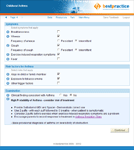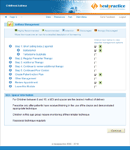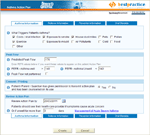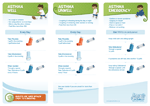Childhood Asthma

Introduction
The bestpractice Childhood Asthma module assists clinicians in providing the most appropriate course of action for a patient depending on their symptoms and history. Individualised advice about what treatment to consider and when referral is appropriate is offered, as well as a personalised asthma action plan for each patient.
Background
New Zealand has one of the highest rates of childhood asthma in the world with 25 per cent of children aged 6-7 years and 30 per cent of adolescents 13-14 years reporting asthma symptoms. The prevalence has fallen in the last decade but significant challenges remain such as diagnosis, adherence and ethnic disparities.
Once a diagnosis of asthma is confirmed, management follows a stepwise progression depending on the success of pharmacological agents to bring symptoms under control. Once control of asthma has been achieved and maintained, children should be maintained on the lowest possible dose of inhaled corticosteroid.
How it works
The BPAC Inc web-based Decision Support system offers three customised options to users.
-
Progression through an initial consultation for a patient presenting with symptoms/risk factors for asthma. The probability of asthma is determined from this information and then management recommendations are provided.
The initial assessment of asthma to confirm a diagnosis in children should focus on the presence of key features and clinical findings. Key features of asthma are:
- recurrent wheeze and breathlessness with or without cough
- variation in the intensity and duration of symptoms
- symptom-free periods.
The Childhood Asthma module allows the practitioner to record the symptoms of suspected asthma and provides information on alternative diagnoses. Various clinical factors increase or decrease the probability of asthma and, along with reversibility testing, help in confirming the diagnosis of asthma.
-
Control and treatment of previously diagnosed asthma using a stepwise approach. This section includes information about appropriate choice of devices, dose, possible non-pharmacological management and when to refer.
Once a diagnosis of asthma has been made, the bestpractice Decision Support Childhood Asthma module confirms if asthma is controlled before making recommendations for ongoing management. The options for managing each patient are listed along with the extent to which each would be recommended. These vary from Highly Recommended actions, i.e. those where failure to choose this action could strongly impact patient health, through to Strongly Discouraged actions where choosing this action could impair patient health.
The recommendations follow a stepwise approach with add-on therapy and options for referral or review included if there is persistent poor control.
Once control of asthma has been achieved and maintained, stepping down of treatment can be considered.
-
Use the module to create a personalised Action Plan which clearly illustrates to the patient and caregivers:
- What inhaler to take
- When to take it
- How much to take
- What to do in the event of an emergency
- What might trigger the patient’s asthma.
Two copies of the Action Plan are available:
- A low resolution copy can be printed at the practice in black and white or emailed to the patient if desired
- Two high resolution colour copies can be generated and posted directly to the patient at their address.
External links
- Guidelines for the Management of Asthma in Children Aged 1-15 years 2005 from Paediatric Society of New Zealand
- Special Edition: Childhood Asthma, May 2009 from Best Practice Journal
Featured module

The Depression in Young People module addresses the identification of common mental disorders and the management of depression in primary care.
For more modules see the full list of standard modules.
Latest News
ACC18 Enhancements - Effective 27 November
Calendar, Printing and ACC Identifiers
In response to feedback, the online ACC18 continues to launch enhancements; the following will be available from 27 November.
Fitness for Work Tab - Calendar: Moving the mouse over the calendar for longer periods has been made easier.
Declaration Tab - ACC Identification: There will be a reduction in the number of identifiers from five to four; no direct impact on the Provider.
If you are one of the over 2000 Practitioners who regularly use the online ACC18; thank you. If you are not then now would be a good time to begin, noting that additional return to work assistance for patients is offered solely through this online form. Self service for setting up and using the online ACC18 is available at www.acc.co.nz (use keyword eACC18 Self Service). However, feel free to contact ACC at 0800 222 994 or ebusinessinfo@acc.co.nz for more personalised support.
Most Popular Modules
The five most popular modules in June were:
- Patient Prompt
- The Common Form
- e-Referral System
- ACC 18 Form
- CVD Quick Screen
To see more, go to the Statistics page.
Getting Started guide
The Getting Started guide is a good place to start if you are new to bestpractice Decision Support. The articles in the guide provide a quick and focussed introduction to the areas of most interest to new users of bestpractice.
About BPAC Inc
bestpractice Decision Support is produced by BPAC Inc. To find out more about us, click here.











